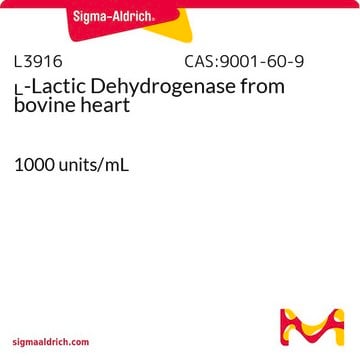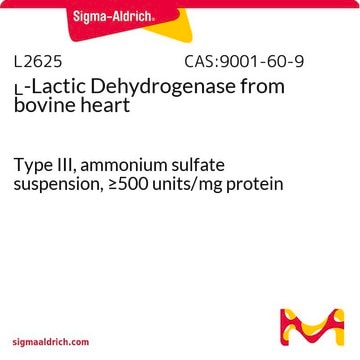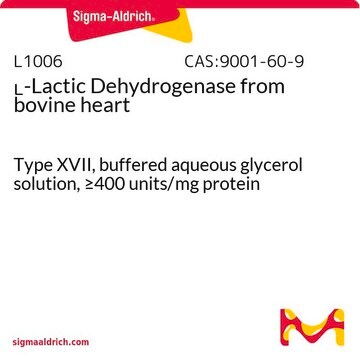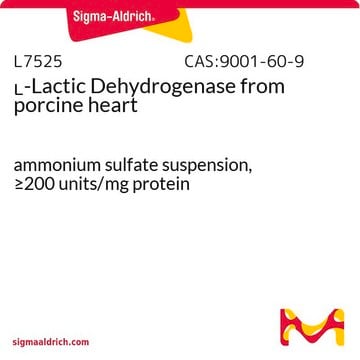LLDH-RO
Roche
L-Lactate Dehydrogenase (L-LDH)
About This Item
Produtos recomendados
fonte biológica
rabbit muscle
Nível de qualidade
forma
suspension
atividade específica
~550 units/mg protein (at 25 °C (1,100 U/mg at 37 °C) with pyruvate as the substrate.)
peso molecular
140,000 Da
embalagem
pkg of 10 mL (10127884001 [100 mg])
pkg of 2 mL (10127230001 [10 mg])
pkg of 5 mL (10127876001 [25 mg])
fabricante/nome comercial
Roche
técnica(s)
activity assay: suitable
cor
white
pH
6.0-7.0
solubilidade
water: miscible
nº de adesão NCBI
nº de adesão UniProt
aplicação(ões)
life science and biopharma
atividade externa
Aldolase <0.001%
GOT <0.01%
GPT <0.01%
MDH <0.01%
PK <0.001%
myokinase <0.01%
Condições de expedição
wet ice
temperatura de armazenamento
2-8°C
Informações sobre genes
rabbit ... LOC100355262(100355262)
Descrição geral
L-lactate dehydrogenase catalyzes the reversible reduction of pyruvate to L-lactate.
Especificidade
Aplicação
Sequência
Therefore, 5 electrophoretically distinguishable LDH isoenzymes, LDH-1 through LDH-5, of differing subunit composition, are found in mammals.
The molecular weight of all LDH isoenzymes is approximately the same.
– LDH-1 (H4), LDH-2 (H3M): predominant components of heart LDH
– LDH-3 (H2M2): principal component of LDH from lymphatic tissue
– LDH-4 (HM3), LDH-5 (M4): predominate in skeletal muscle or liver LDH
Note: The M subunit of LDH used to be designated the A subunit; the H subunit was the B subunit. Under the old designation, LDH-1 isoenzyme was LDH-B4.
Definição da unidade
Note: For preparations H and I, the activity is defined at +30 °C, pH 7.8. The above assay consumes 1 mol of NADH per mol of pyruvate reduced.
Unit Conversion: For the reduction reaction, pyruvate as substrate:
1 U (+25 °C) 1.5 U (+37 °C) [hog muscle LDH in glycerol].
1 U (+25 °C) 1.8 U (+37 °C) [hog muscle LDH in amm onium sulfate].
1 U (+25 °C) 1.1 U (+30 °C) 2.0 U (+37 °C) [rabbit muscle LDH].
1 U (+25 °C) 1.4 U(+30 °C) 2.5 U (+37 °C) [pig heart LDH].
1 U (+25 °C) 2.5 U (+37 °C) [beef heart LDH].
forma física
Nota de preparo
Nota de análise
Outras notas
Código de classe de armazenamento
12 - Non Combustible Liquids
Classe de risco de água (WGK)
WGK 1
Ponto de fulgor (°F)
does not flash
Ponto de fulgor (°C)
does not flash
Certificados de análise (COA)
Busque Certificados de análise (COA) digitando o Número do Lote do produto. Os números de lote e remessa podem ser encontrados no rótulo de um produto após a palavra “Lot” ou “Batch”.
Já possui este produto?
Encontre a documentação dos produtos que você adquiriu recentemente na biblioteca de documentos.
Os clientes também visualizaram
Nossa equipe de cientistas tem experiência em todas as áreas de pesquisa, incluindo Life Sciences, ciência de materiais, síntese química, cromatografia, química analítica e muitas outras.
Entre em contato com a assistência técnica











